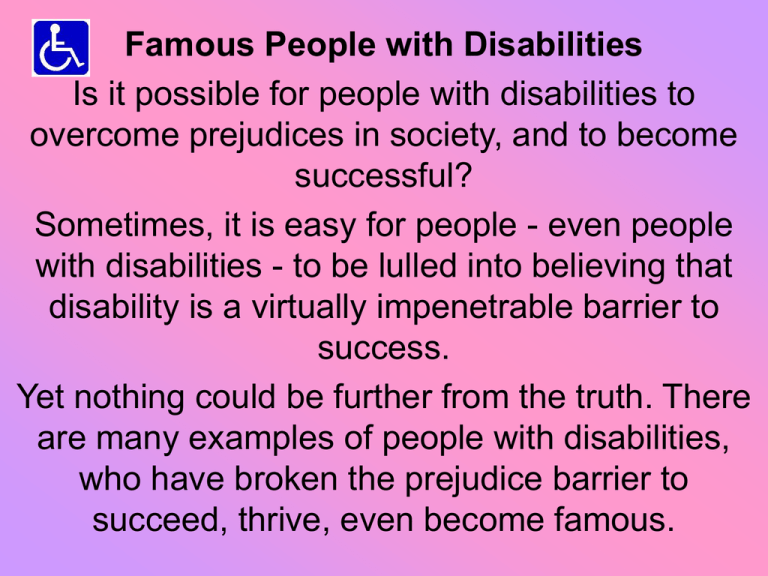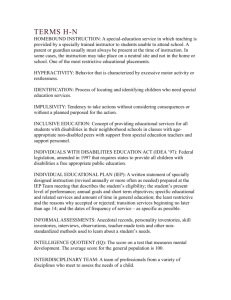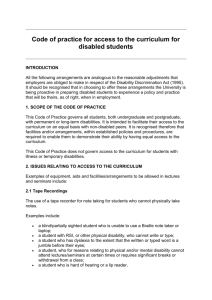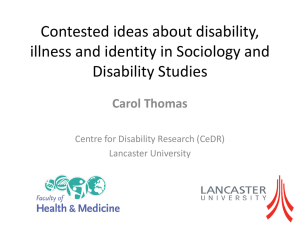Famous People with Disabilities
advertisement

Famous People with Disabilities Is it possible for people with disabilities to overcome prejudices in society, and to become successful? Sometimes, it is easy for people - even people with disabilities - to be lulled into believing that disability is a virtually impenetrable barrier to success. Yet nothing could be further from the truth. There are many examples of people with disabilities, who have broken the prejudice barrier to succeed, thrive, even become famous. Albert Einstein • The Mathematician/Physicist who had a learning disability and did not speak until age 3. He had a very difficult time doing maths in school. It was also very hard for him to express himself through writing. Alexander Graham Bell Had a learning disability Stephen Hawkings •Physicist/mathematician has Lou Gehrigs Disease and is in a wheelchair. •He needs a computer to speak. Franklin D. Roosevelt • Roosevelt had Polio, was governor of New York State then elected President of the United States for 4 terms. George Washington • Had a learning disability. He could barely write and had very poor grammar skills. Lord Nelson • Viscount Horatio Nelson is certainly Britain's greatest naval hero. His skill as a naval commander is, of course, well-documented. He won crucial victories at Trafalgar in 1805 and the Battle of the Nile in 1798, during the wars with revolutionary and Napoleonic France. What is less often remarked upon is that a great part of his naval career and his major victories were won as a disabled person. Going ashore in Corsica following the fall of Toulon, a French shot flung debris into his face leaving him without sight in his right eye. Later, an assault on Tenerife resulted in a shattered right elbow - back on his flagship the arm was amputated. He carried on as a disabled seaman for nearly ten years, securing his most important naval victories at the Battle of the Nile and the infamous Battle of Trafalgar - where he died on October 21, 1805. Contrary to popular belief, he didn't say "I see no ships". Instead he said, during the Battle of Copenhagen, "... I have only one eye. I have a right to be blind sometimes" and, raising his telescope to his blind eye, "I really do not see the signal". Goya • Spanish painter (1746-1828): At age 46, an illness left him deaf. He went on to create the most famous Spanish art of the 19th century. Lord Byron • "Mad, bad and dangerous to know", Britain's great romantic was also born with talipes, a club foot. It is said that he "walked with difficulty but wandered at will". He toured Europe extensively and captured the popular imagination through his poetry and his personality. Disability activist Tom Shakespeare summed him up in the following way: "Most of his poetry hasn't stood the test of time, but he was a blockbuster in his day, and like very few other heroes, his name is still used as an adjective - 'Byronic', meaning dashing.” Walt Disney Walter Elias Disney (December 5, 1901 – December 15, 1966) was a twenty-two time Academy Award winning. American film producer, director, screenwriter, voice actor, animator, entrepreneur, visionary and philanthropist. His name is a household word among people who have little or no knowledge of American film. It is even familiar to children. Walt had a learning disability Walt became one of the best-known motion picture producers in the world. He was nominated for 48 Academy awards and 7 Emmys, holding the record for most Oscar nominations. Sarah Bernhardt •French actress (18441923) Disabled by a knee injury, her leg amputated in 1914, she continued starring on stage until just before her death. She is regarded as France's greatest actress -- "The Divine Sarah". Sudha Chandran (Indian actress and classical dancer) This brave lady dances with a Jaipur foot. She has acted in a movie on classical dance called "Nache Mayuri" & today acts in a variety of TV serials. Tanni Grey-Thompson • Tanni Carys Davina Grey-Thompson OBE to give her full name and title - is the disabled athlete that most people instantly recognise. Formerly Tanni Grey - the Thompson was added following her marriage in 1999 - she has competed in Paralympic Games since 1988, representing Britain at distances ranging from 100m to 800m. She has won fourteen paralympic medals including nine golds, and has broken over twenty world records. As a wheelchair athlete she was also the winner of five London marathons - in 1992, 1994, 1996, 1998 and 2001. In recent years, she has established herself as a TV presenter including BBC TWO's From the Edge disability magazine programme. Tom Cruise • Tom Cruise is quite possibly the biggest movie star in the world. He earns $20 million a picture, is sought after by the world's top directors, and with maturity is inching closer and closer to the inevitable Oscar. He's married to a beautiful movie star, owns a fleet of expensive cars and planes. Yes, Tom Cruise just might be the luckiest man in the world. Not bad for a high school drop-out from a broken home who has battled dyslexia and the vagaries of Hollywood to achieve superstardom on a truly global scale. • What's more, for everyone listed as "famous", there are thousands - millions, even - of people with disabilities who are quite competent in the jobs we do. Besides, our value as people is not limited to the economic wealth which we produce. Every human, whether disabled or not, is a unique and valuable individual. Parents, children, carers , volunteers and amateurs (ie unpaid enthusiasts) are not paid for the work they do, but that certainly doesn't mean they are of no value to society!











